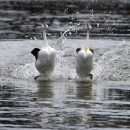The U.S. Fish and Wildlife Service has prepared a Habitat Management Plan (HMP) for the Bear River Migratory Bird Refuge (Refuge or Bear River MBR) in Utah. The following summary provides a brief overview of the plan including (1) a general description of the Refuge, (2) purpose of plan, (3) goals and objectives, and (4) the proposed projects.
The goals and objectives developed for the HMP were developed to support the mission of the National Wildlife Refuge System and the purposes for which the Refuge was established. They are based on the principle of ecological sustainability, which requires ensuring the long-term productivity of habitats. In this context, the Refuge HMP is focused on providing habitats necessary to provide the resources (e.g., foods and plant structure) needed to fulfill life cycle events (e.g., migration, staging, feeding, and breeding) of species using the Refuge, with an emphasis on focal species and guilds. Focal species and guilds identified include, 1) American white pelican, 2) American avocet, 3) black-necked stilt, 4) cinnamon teal, 5) white-faced ibis, 6) tundra swan, 7) snowy plover, 8) migratory waterfowl, and 9) migratory shorebirds. The goals of this HMP are as follows.
GOAL 1. Restore and manage Bear River deltaic wetland habitats and River Corridor units to emulate historic natural hydrology, where possible, to provide migration and breeding habitat for a diversity of waterfowl, wading birds and shorebirds.
GOAL 2. Restore and manage wet meadow and upland habitats in the Wasatch Front to produce native grasses, sedges, rushes, and forbs, where possible, to provide foraging and breeding habitat for a diversity of waterfowl, wading birds, and shorebirds.
GOAL 3. Prevent further physical alterations to maintain the existing hydrologic and topographic integrity of the Refuge.
Bear River Migratory Bird Refuge Habitat Management Plan
Executive Summary iv
GOAL 4. Maintain and expand partnerships that contribute to the conservation and enhancement of Refuge habitats, the Bear River watershed, and the GSL Ecosystem


